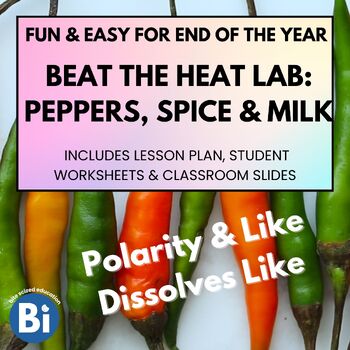Beat the Heat- Spice in Peppers (Fun & Easy End of Year Science Activities)
Grade Levels
6th - 9th
Subjects
Resource Type
Standards
NGSSMS-PS1-3
NGSSMS-LS1-8
Formats Included
- Google Drive™ folder

Made for Google Drive™
This resource can be used by students on Google Drive or Google Classroom. To access this resource, you’ll need to allow TPT to add it to your Google Drive. See our FAQ and Privacy Policy for more information.
Description
This lesson centers around a lab where students make their own spicy pepper butter to explore what parts of a pepper are spiciest and which peppers are spiciest. Then students try out different drinks to see which one is best for giving relief from spice! It's a fun and easy lab that can be used to explore the anatomy of peppers and how our sensory neurons work.
This Lesson Includes all of these materials:
- 3-Part Lab: Spice in Peppers
- Materials, Ingredients, and Prep for Lab
- 2 Videos: Instructional How-To Lab Video + "Science Behind" Video that explains key concepts and shows our own experimentation
- Classroom Slides with discussion prompts, lesson flow, and embedded videos
- Detailed Lesson Plan
All materials are included in a Google Drive folder
Total Pages
Answer Key
N/A
Teaching Duration
1 hour
Report this resource to TPT
Reported resources will be reviewed by our team. Report this resource to let us know if this resource violates TPT’s content guidelines.
Standards
to see state-specific standards (only available in the US).
NGSSMS-PS1-3
Gather and make sense of information to describe that synthetic materials come from natural resources and impact society. Emphasis is on natural resources that undergo a chemical process to form the synthetic material. Examples of new materials could include new medicine, foods, and alternative fuels. Assessment is limited to qualitative information.
NGSSMS-LS1-8
Gather and synthesize information that sensory receptors respond to stimuli by sending messages to the brain for immediate behavior or storage as memories. Assessment does not include mechanisms for the transmission of this information.


